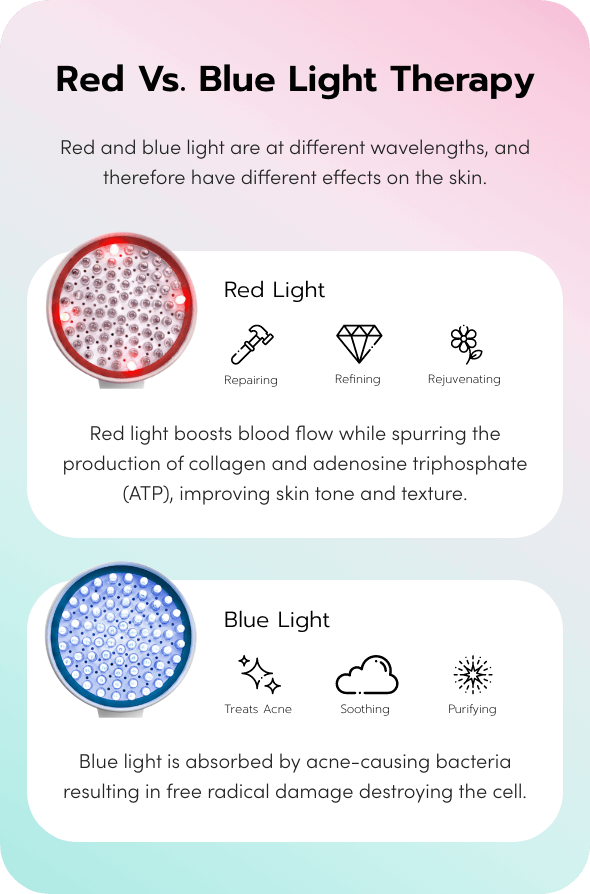Last Updated on 1 year by Francis
As the debate between red light and blue light therapy continues to rage, it’s important to understand the pros and cons of each type of therapy before deciding which one is best for you. Red light therapy is gaining in popularity due to its ability to stimulate collagen production, increase circulation, and reduce inflammation. Blue light therapy is becoming increasingly popular for its ability to reduce acne, improve sleep, and improve mood. In this article, we’ll discuss the benefits and drawbacks of each type of therapy so that you can make an informed decision about which one is best for you.
Red light therapy and blue light therapy are both effective treatments for a variety of skin conditions, but which is better? It depends on what you’re trying to treat. Red light therapy is used to reduce inflammation and speed up wound healing, while blue light therapy is used to kill bacteria and treat acne.
Red light therapy is generally thought to be more effective for healing wounds and reducing inflammation, while blue light therapy is better at killing bacteria and treating acne. Both treatments can have some side effects, such as skin irritation and reddening, but these usually fade within a few days.
The best way to determine which treatment is right for you is to consult with your dermatologist. They can assess your skin condition and determine which therapy is best suited for you.

Contents
What is Red Light Therapy and Blue Light Therapy?
Red Light Therapy and Blue Light Therapy are both light-based treatments that use different wavelengths of light to treat various skin conditions. Red Light Therapy is a non-invasive procedure that uses low-level laser (light) to stimulate the skin’s natural healing processes. It is used to treat acne, wrinkles, scars, and other skin conditions. Blue Light Therapy is a type of phototherapy that uses high-intensity blue light to kill the bacteria that cause acne.
What are the Benefits of Red Light Therapy?
Red Light Therapy is known for its anti-aging benefits and ability to reduce the appearance of wrinkles and fine lines. It can also help to even out skin tone, reduce pore size, and improve skin texture. Red Light Therapy is also known to help reduce inflammation and stimulate collagen production, making it a great option for treating acne scars and other skin issues.
What are the Benefits of Blue Light Therapy?
Blue Light Therapy is primarily used to treat acne, as it can kill the bacteria that causes it. It is also known to reduce inflammation, reduce redness, and reduce the size of sebaceous glands. Blue Light Therapy can also help to reduce oil production in the skin, making it an effective treatment for oily or combination skin types.
Which is Better Red Light or Blue Light Therapy?
The answer to this question depends on the individual and their skin type. Red Light Therapy can be beneficial for anti-aging, reducing wrinkles, and improving skin texture, while Blue Light Therapy is better for treating acne and reducing inflammation. It is best to consult a dermatologist to determine which light therapy is best for you.
How Does Red Light Therapy Work?
Red Light Therapy works by using low-level lasers to stimulate the production of collagen and elastin in the skin. The light also increases circulation and helps to reduce inflammation. This type of therapy is also known to help reduce the appearance of wrinkles and fine lines, as well as improve skin tone.
How Does Blue Light Therapy Work?
Blue Light Therapy works by emitting a high-intensity blue light that penetrates deep into the skin. The light kills the bacteria that cause acne, reducing inflammation and redness. It also helps to reduce oil production in the skin, making it an effective treatment for oily or combination skin types.
What are the Side Effects of Red Light and Blue Light Therapy?
The most common side effects of Red Light Therapy are mild redness, itching, and irritation. These side effects usually go away after a few treatments. Blue Light Therapy is generally safer than Red Light Therapy, and the most common side effects are itching, redness, and dryness. In both cases, it is best to consult a dermatologist to ensure that there are no contraindications.
Are there any Contraindications for Red Light Therapy?
Yes, there are some contraindications for Red Light Therapy. It is not recommended for those who are pregnant, have an active infection, or have an active skin disease. It is also not recommended for those who have a history of skin cancer or are taking certain medications.
Are there any Contraindications for Blue Light Therapy?
Yes, Blue Light Therapy also has some contraindications. It is not recommended for those who are pregnant, have an active infection, or are taking certain medications. It is also not recommended for those who have a history of skin cancer or are taking photosensitizing medications.
Frequently Asked Questions
Question 1: What is red light therapy?
Answer: Red light therapy is a type of light therapy that utilizes a low-level, non-thermal, red light in the visible spectrum, usually in the range of 633 nanometers. This light is used to treat a variety of skin issues, from wrinkles and acne to pain relief and inflammation. It is generally considered a safe and non-invasive procedure and is often used in combination with other treatments, such as microneedling and laser treatments.
Question 2: What is blue light therapy?
Answer: Blue light therapy is a type of light therapy that utilizes a low-level, non-thermal, blue light in the visible spectrum, typically in the range of 415 nanometers. This light is used to treat a variety of skin issues, from acne and sun damage to rosacea and psoriasis. It is generally considered a safe and non-invasive procedure and is often used in combination with other treatments, such as chemical peels and microdermabrasion.
Question 3: What are the benefits of red light therapy?
Answer: The benefits of red light therapy are numerous, including reducing wrinkles, improving skin texture and tone, reducing inflammation, and promoting healing. It can also be used to treat pain, aid in wound healing, and reduce redness and swelling. Additionally, red light therapy can help to stimulate collagen production and reduce the appearance of scars.
Question 4: What are the benefits of blue light therapy?
Answer: The benefits of blue light therapy are many, including reducing the appearance of acne, reducing inflammation, and helping to reduce the appearance of sun damage. Additionally, blue light therapy can help to stimulate collagen production, reduce the appearance of scars, and reduce redness and swelling.
Question 5: Is red light therapy or blue light therapy better?
Answer: It depends on the skin condition being treated. Red light therapy is generally better for treating wrinkles, improving skin texture and tone, and reducing inflammation. Blue light therapy is generally better for treating acne, sun damage, rosacea, and psoriasis.
Question 6: Are there any side effects to red light therapy or blue light therapy?
Answer: Generally, there are no side effects to either red light therapy or blue light therapy. However, it is important to consult with a dermatologist before beginning any light therapy treatment to ensure that it is safe and appropriate for your skin type and condition. As with any treatment, there is always a possibility of some minor side effects, such as redness or irritation of the skin.
Red light therapy vs blue light therapy
In conclusion, red light therapy and blue light therapy are both very beneficial in achieving a range of health benefits. Ultimately, the choice between them is dependent on the individual’s desired outcome. Red light therapy is ideal for skin health, while blue light therapy is better for treating insomnia and depression. It is important to consult with a healthcare professional to determine which option is best for your needs and goals.







